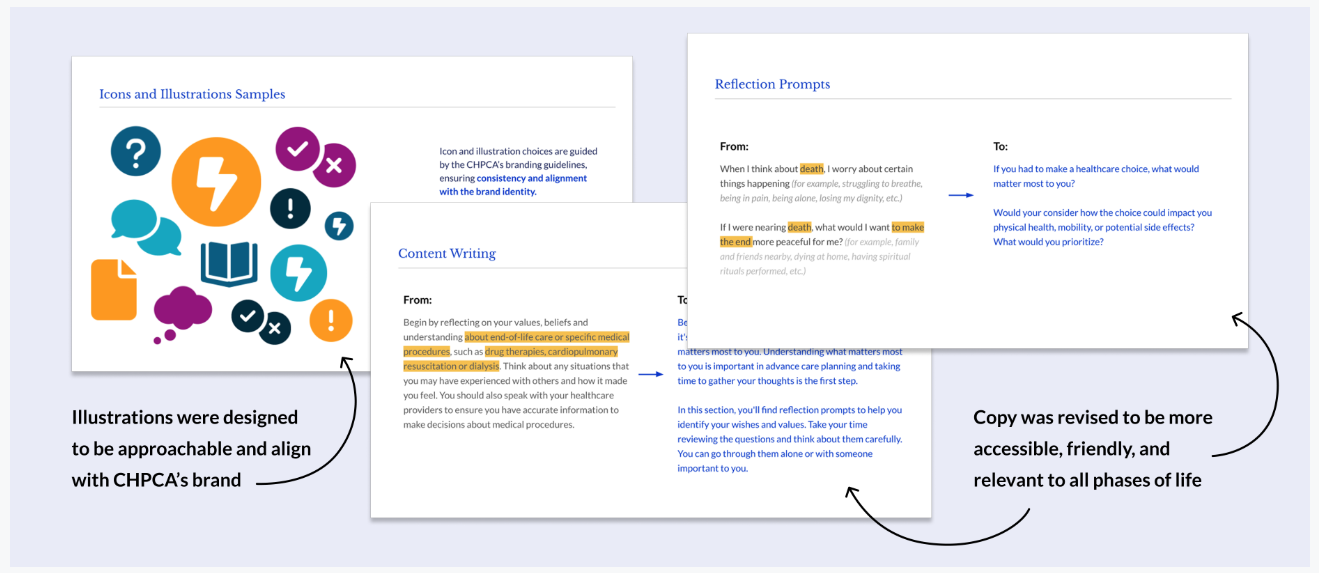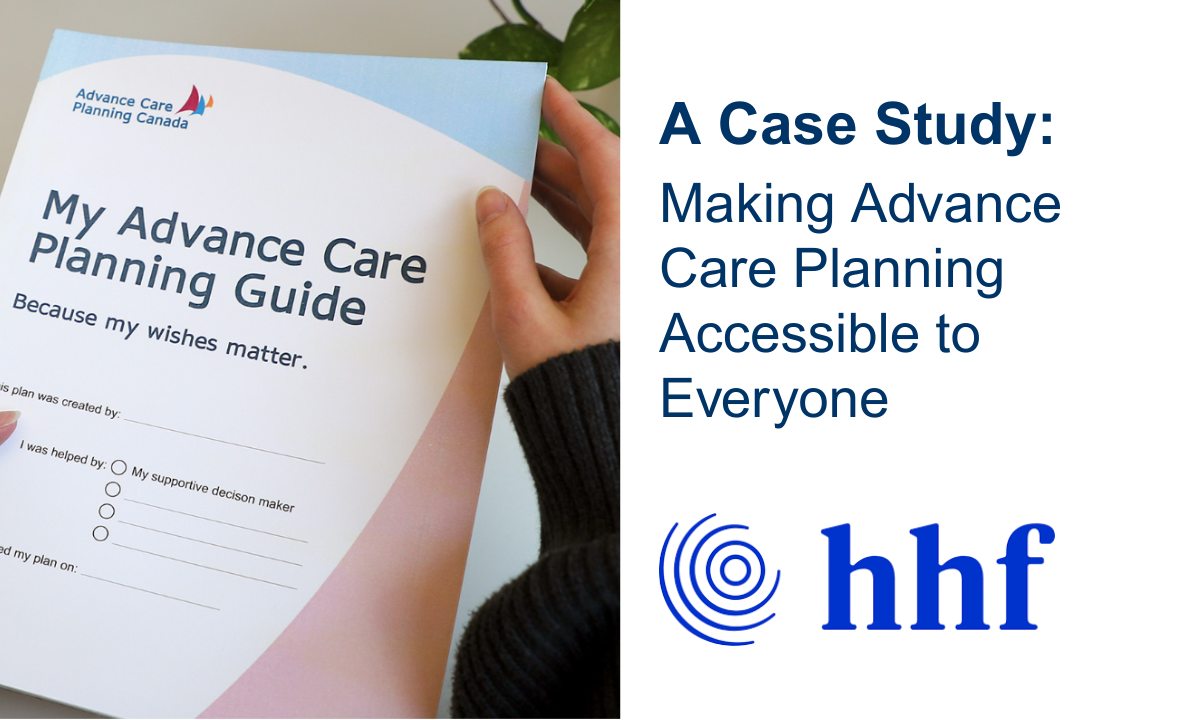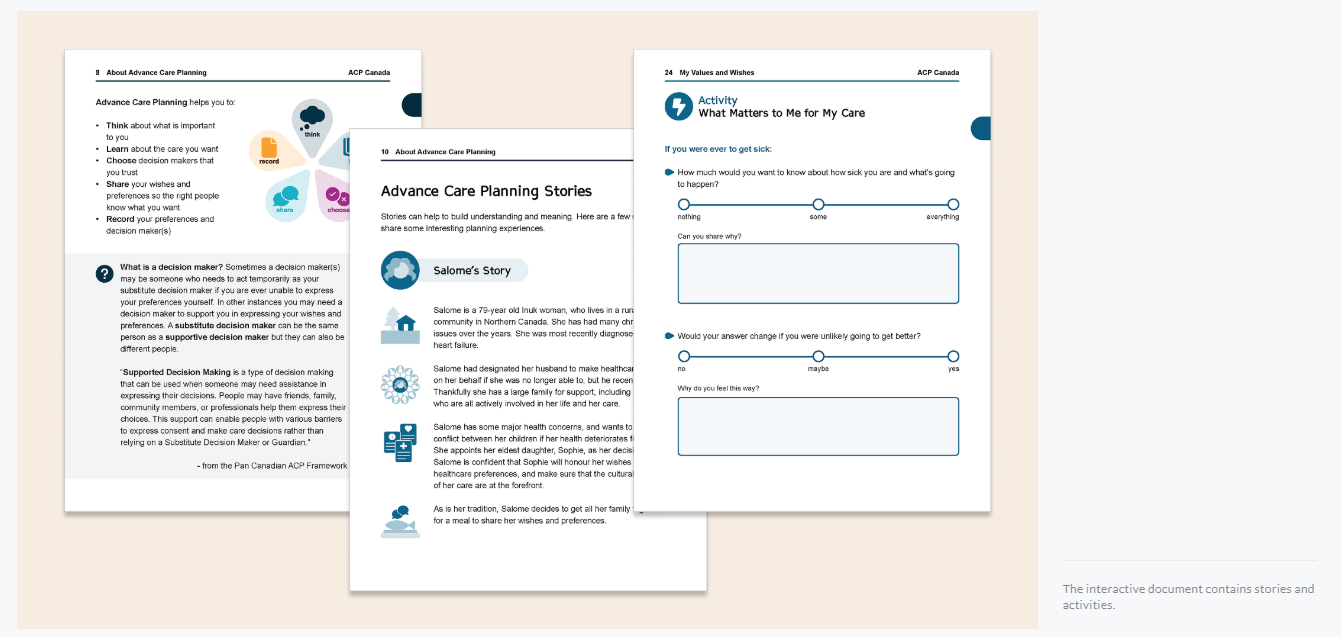Case Study: Making Advance Care Planning Accessible to Everyone
April 23, 2025
This case study was originally posted on the Human Health Factors website.
Human Health Factors (HHF) worked with the Canadian Hospice Palliative Care Association to redesign their advance care planning guide to better meet the needs of a shifting advance care planning landscape, improve accessibility and inclusivity, and create more opportunities for people to reflect and plan at any stage of life.
Services: Environmental Scans, Co-Design Workshops, Content Writing, Communication Design
Challenge
As ACP evolves across Canada from an end-of-life model – focused primarily on decisions made near the time of death – to a broader life planning model, and as laws shift to embrace a more open and inclusive view of what it means for a person to be able to express their wishes and preferences, we need to consider how we create more opportunities for people to reflect and plan at any stage of life.
Using a human-centred design approach, we partnered with the Canadian Hospice Palliative Care Associate (CHPCA) to reimagine how an ACP guide might better serve the needs of all Canadians, including people living with disabilities whose voices have historically been excluded from conversations about their care.
Process
Discovery
Starting with interviews and moving through a series of exploratory and co-design workshops, our team engaged with ACP educators, healthcare providers, and people with lived experiences (PWLE), who either created their own advance care plan or supported others in doing so. Integrating an inclusive design approach, our team also engaged with people living with disabilities and professionals in the disability and inclusion space.
Learning from the lived experiences of people living with disabilities allowed us to recognize ableist and exclusionary practices, both within our approach and embedded within the ACP guide itself. By recognizing that all people have a range of abilities and limitations, we understood that designing for the needs of people living with disabilities inherently caters to a broader range of users.
ACP is, above all else, a journey. People will come to ACP with varying levels of knowledge, both of what ACP is and their own self-awareness. An ACP guide must support people in all the diverse ways they may embark on their journey.
HHF Guiding Principles
Our guiding principles spotlighted the needs of people with lived experiences and ACP experts to ensure these voices remained at the forefront as designs were developed and refined.
People want to be able to find the right information at the right time: A guide should support knowledge building and provide needed information.
People want guidance exploring what matters most to them: A guide should prompt reflection and help people capture their authentic wishes.
People want support translating their wishes into choices: A guide should encourage action and prompt next steps.
People want information that matches their individual needs: A guide should provide information in many different ways and support inclusion and diversity.
People want help building mutual understanding: A guide should invite collaboration and conversation while helping people find their support networks and align with their decision supporters.
Design
An environmental scan and review of the existing CHPCA’s ACP guide highlighted opportunities to shift the guide content from that of an end-of-life framing towards a broader life-planning model. Through a shift in language, tone, and reflection prompts, the new content became more open, inviting, and relevant to people at any stage of life while providing foundational information to guide people through their ACP journey.
An added update of legal terminology reflected the evolving national framework, aligning the content with other successful ACP tools, and emphasizing ACP as an ongoing process based on personal values, relationships, and community—not a one-time document.

The core sections focus on exploring values, wishes, and preferences, building a support network, sharing wishes and preferences, and recording a plan. Stories, activities, and graphics were added to support engagement throughout the guide, providing opportunities for learning and reflection.
Accessibility was an important objective throughout. The digital version was tested with popular screen readers, designed to meet or exceed AODA standards, and is home printer friendly. High-contrast colours, readable fonts, and white space were used to create a guide that is easy to use, both digitally and on paper.
Outcomes
The guide provided a foundation for several other resources that have since been created, including a mini-guide, exercise bundle, brochures, postcards, and an easy read version. All versions of the guide and related resources are available in digital format on the Advance Care Planning website.
About Human Health Factors
Since 2004, Human Health Factors been working to transform healthcare experiences, products, services, and systems by combining design and engineering with an in-depth understanding of humans and healthcare. https://humanfactors.ca/
Have an article you’d like to submit?
Contact us at: [email protected]




